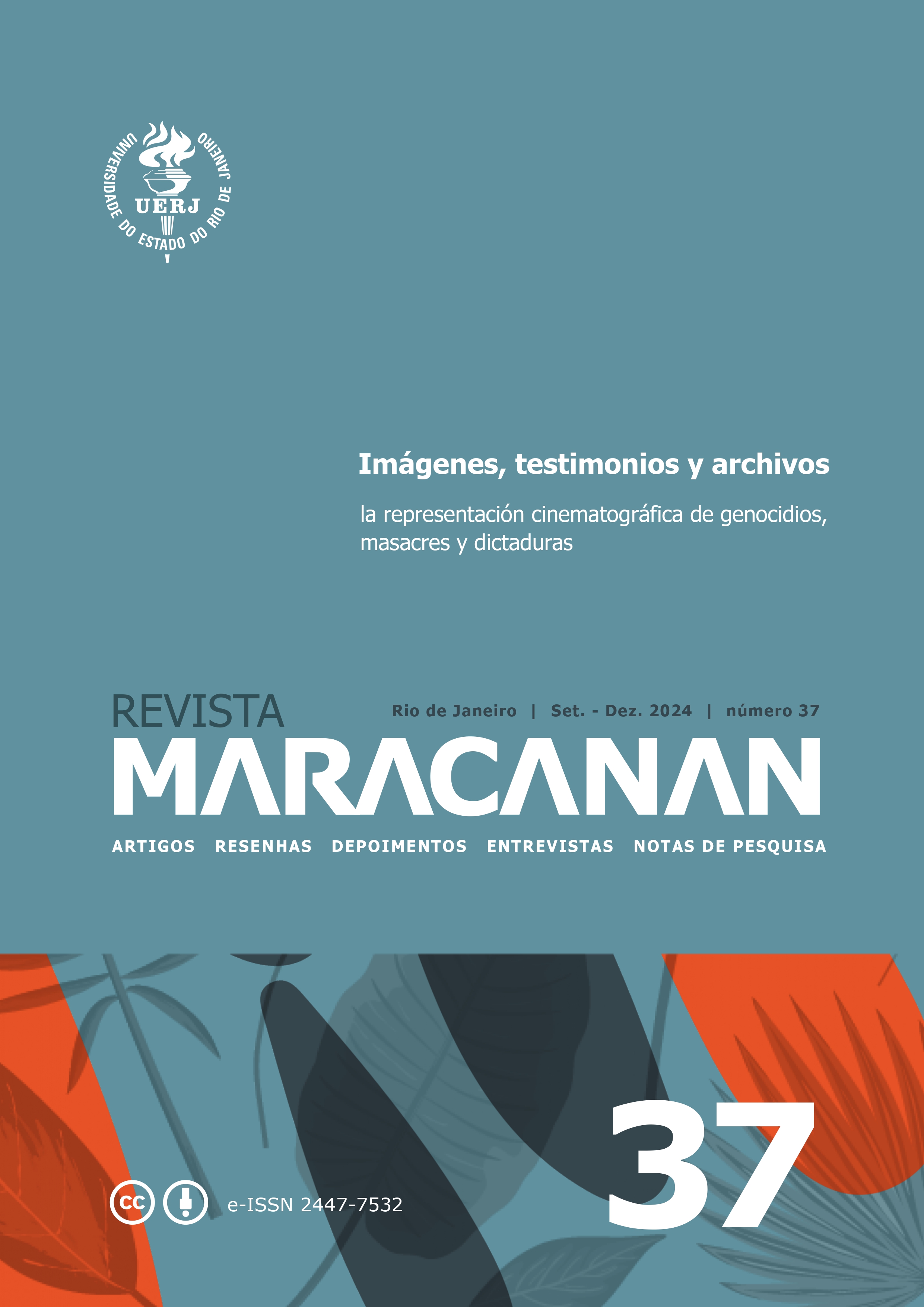Testimonies in spite of all.
On Camuflaje (Perel, 2022)
DOI:
https://doi.org/10.12957/revmar.2024.84356Keywords:
Representation, Genocide, Camuflaje, TestimonyAbstract
This work analyzes the film Camuflaje (Perel, 2022), considering its choices in representating of the last Argentine civil-military dictatorship – and the validity of its effects –, as evidenced in the characterization it makes of one of its spaces: the emblematic Campo de Mayo garrison, where several clandestine torture and detention centers operated. The narrative structure of the film is organized based on the presence of conversations and dialogues between the writer Félix Bruzzone and a group of people linked in various ways to Campo de Mayo. The approach problematizes the relationships between the word and the image, the entity of the testimony, the limits of representation, the links between past and present times and the relevance of using “formulas of representation” (Burucúa; Kiatkowski, 2014), to give an account of the links between a historical event included in the category of genocide and the ways of considering it from the point of view of cultural production, in this case filmic discourse.
Downloads
References
BRUZZONE, Félix. “Campo de Mayo”: cuando la mejor forma de sobrevivir es mantenerse en movimiento. Infobae, 27 jun. 2019. Disponible en: https://www.infobae.com/cultura/2019/06/27/campo-de-mayo-cuando-la-mejor-forma-de-sobrevivir-es-mantenerse-en-movimiento/. Accesso en: mar. 2024.
BRUZZONE, Félix. Campo de Mayo. Buenos Aires: Penguin Random House, 2019.
BURUCUA, José Emilio; KWIATKOWSKI, Nicolás. Cómo sucedieron estas cosas: Representar masacres y genocidios. Buenos Aires: Katz, 2014.
CANTONI, Federico. Carreras de la memoria: corporalidad, dinamismo y performatividad en Campo de Mayo de Félix Bruzzone. Catedral Tomada, Revista de Crítica Literaria Latinoamericana, v. 9, n. 16, 2021.
CASTILLO, Marcelo; GONZÁLEZ TIZÓN, Rodrigo. Investigar Campo de Mayo. Los “vuelos de la muerte” en Campo de Mayo. Buenos Aires: Ministerio de Justicia y Derechos Humanos de la Nación, Secretaría de Derechos Humanos, 2023.
DE LA PUENTE, Maximiliano. Campo de mayo: la (pos)dramatización y ficcionalización de las memorias sobre el terrorismo de Estado. Actas del […]. Congreso Latinoamericano de Comunicación de la UNVM, II. Instituto Académico Pedagógico de Ciencias Sociales, Universidad Nacional de Villa María. Córdoba, 2020. Disponible en: https://www.aacademica.org/segundo.congreso.latinoamericano.de.comunicacion.de.la.unvm/67. Accesso en: mar. 2024.
DIDI-HUBERMAN, Georges. Imágenes pese a todo. Memoria visual del Holocausto. Barcelona: Paidós, 2004.
FEIERSTEIN, Daniel. [Sin título]. In: FEIERSTEIN, Daniel; RAFECAS, Daniel; BARLETTA, Ana María; CRUZ, Verónica. Panel “Genocidio y negacionismo. Disputas en la construcción de la memoria”. Aletehia, v. 8, n. 5, 2017. Disponible en: http://www.memoria.fahce.unlp.edu.ar/art_revistas/pr.8240/pr.8240.pdf. Accesso en: mar. 2024.
GOMEZ, Laura. Félix Bruzzone y Jonathan Perel antes del estreno de “Camuflaje”. Página 12, 23 mar. 2023. Disponible en: https://www.pagina12.com.ar/534043-felix-bruzzone-y-jonathan-perel-antes-del-estreno-de-camufla. Accesso en: 23 mar. 2024.
KEIZMAN, Betina. Las vidas que transcurren (una lectura de la performance “Campo de Mayo” de Félix Bruzzone). TRANS Revue de littérature générale et comparée, París, n. 19, 2015. DOI: https://doi.org/10.4000/trans.1198.
PELLER, Mariela. (No) seguir buscando a mamá. Perfomance y posmemoria en Campo de mayo de Félix Bruzzone. Kamchatka. Revista de análisis cultural, Valencia, n. 11, 2018.
PEREZ, Mariana Eva. Campo de Mayo: ¿Qué harías vos acá? Revista Anfibia, 15 feb. 2022. Disponible en: https://www.revistaanfibia.com/campo-de-mayo-que-harias-vos-aca/. Accesso en: 23 mar. 2024.
TOSORATTI, Cecilia. La (re)presentación del desaparecido como figura espectral en tres conferencias performáticas. Actas del 1º Congreso Internacional de Artes, Universidad Nacional de las Artes, 2014. Disponible en: https://congresointernacionaldeartes.una.edu.ar/files/actas/0344.pdf. Accesso en: 23 mar. 2024.
VECCHIOLI, Virginia. El centro clandestino Campo de Mayo por dentro en realidad virtual. Tiempo Argentino, 5 abr. 2018. Disponible en: https://www.tiempoar.com.ar/politica/el-centro-clandestino-campo-de-mayo-por-dentro-en-realidad-virtual/. Accesso en: 23 mar. 2024.
VERZERO, Lorena. Teatralidad, memoria y experiencia en la ciudad-cuerpo: Prácticas performáticas en la Buenos Aires del siglo XXI. In: FEENSTRA, Pietsie; VERZERO, Lorena (Orgs.). Ciudades performativas: Prácticas artísticas y políticas de (des)memoria en Buenos Aires, Berlín y Madrid. Buenos Aires: CLACSO, 2020.
WALAS, Guillermina. Alternativas testimoniales: gestión cultural y memoria en Argentina. Revista Iberoamericana, n. 77, 2011. DOI: https://doi.org/10.3828/reviberoamer.2011.77236237885.
Downloads
Published
How to Cite
Issue
Section
License
Copyright (c) 2024 Malena Paula Verardi

This work is licensed under a Creative Commons Attribution 4.0 International License.
The copyrights of originals and translations published are automatically assigned to Revista Maracanan. The information contained in this papers are the sole responsibility of the authors.
The Copyright of the published articles belong to Revista Maracanan, with works simultaneously licensed under a Creative Commons Attribution-NonCommercial-ShareAlike 4.0 International License, which allows the sharing of work with mandatory recognition of authorship and initial publication in this journal, under the same license and for non-commercial purposes.

The Revista Maracanan is licensed with a Creative Commons Attribution-NonCommercial-ShareAlike 4.0 Internacional License.





